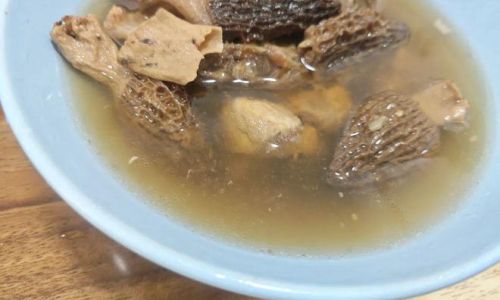Introduction
In the realm of gourmet mushrooms, morel mushrooms (Morchella esculenta) stand out for their unique appearance, rich flavor, and nutritional benefits. These elusive fungi, often resembling a honeycomb or a brain, are highly prized by chefs and food enthusiasts worldwide. Found primarily in temperate forests during spring and early summer, morels have a brief but cherished season, making them a rare delicacy. However, enjoying their earthy, umami-rich taste responsibly involves understanding the appropriate serving size. This guide delves into the intricacies of how much morel mushrooms one should consume in a single sitting, exploring factors such as nutritional content, potential health benefits, and safety considerations.
Nutritional Breakdown of Morel Mushrooms

Before discussing the ideal serving size, let’s examine the nutritional profile of morel mushrooms. These fungi are a treasure trove of essential nutrients, vitamins, and minerals. They are particularly rich in:
- Protein: Morels contain a significant amount of high-quality protein, making them a valuable addition to plant-based diets.
- Fiber: Their fiber content aids in digestion and supports a healthy gut microbiome.
- Vitamins and Minerals: Morels are abundant in vitamins such as B vitamins (riboflavin, niacin, and pantothenic acid), potassium, iron, copper, and selenium. Selenium, in particular, is a powerful antioxidant that helps protect cells from oxidative stress.
- Antioxidants: These mushrooms are loaded with phenolic compounds and ergosterol, which contribute to their antioxidant properties.
- Low in Calories: Despite their rich flavor and nutritional density, morels are relatively low in calories, making them an excellent choice for weight management.
Health Benefits of Morel Mushrooms
The nutritional richness of morel mushrooms translates into numerous potential health benefits. Here are some notable ones:
- Enhanced Immune Function: The high levels of selenium and other antioxidants in morels can bolster the immune system, helping the body fight off infections and diseases.
- Cardiovascular Health: The fiber, potassium, and antioxidants in these mushrooms may support heart health by reducing blood pressure, improving circulation, and lowering cholesterol levels.
- Anti-Inflammatory Effects: The phenolic compounds in morels exhibit anti-inflammatory properties, which can be beneficial for managing chronic inflammatory conditions like arthritis.
- Cancer Prevention: Selenium and other antioxidants in morels may have chemopreventive effects, protecting cells from damage that can lead to cancer development.
- Brain Health: The B vitamins in morels, especially riboflavin and niacin, are crucial for energy production in the brain and support cognitive function.
Determining the Appropriate Serving Size
Given their nutritional benefits, it’s tempting to incorporate morel mushrooms into every meal. However, like any food, moderation is key. The appropriate serving size depends on various factors, including individual dietary needs, overall health status, and the preparation method.

General Guidelines
For most adults, a reasonable serving size of cooked morel mushrooms ranges between 3 to 5 ounces (about 85 to 140 grams). This amount provides a balanced intake of nutrients without overloading the body. It’s important to note that serving sizes may vary slightly based on personal preference and dietary goals.
Factors Influencing Serving Size
- Age and Gender: Generally, men may require larger serving sizes due to their higher caloric needs compared to women. Similarly, younger individuals may have higher energy requirements than older adults.
- Activity Level: Individuals with high physical activity levels may benefit from larger servings to meet their increased energy demands. Conversely, sedentary individuals may require smaller portions to avoid excess calorie intake.
- Dietary Restrictions and Goals: Those following specific diets, such as low-carb, low-sodium, or vegan diets, should adjust their serving sizes accordingly to align with their nutritional needs. For instance, a vegan may consume a larger portion to meet their protein requirements.
- Preparation Method: The way morels are prepared can also affect the appropriate serving size. For example, sautéed or grilled morels may be more calorie-dense due to added fats and oils, whereas soups or stews may be more volume-based and lower in calories.
Safety Considerations
While morel mushrooms are generally safe to consume, there are a few precautions to take:

- Allergies: Some individuals may be allergic to mushrooms, including morels. Symptoms of a mushroom allergy can include skin rash, itching, swelling, respiratory distress, and digestive discomfort. If you suspect an allergy, consult a healthcare provider before consuming morels.
- Toxin Concerns: Morels, especially wild-harvested ones, can sometimes be mistaken for toxic mushrooms. It’s crucial to correctly identify morels and avoid consuming any mushrooms that are unfamiliar or suspected to be poisonous.
- Cooking: Always cook morel mushrooms thoroughly before eating to reduce the risk of foodborne illness. Raw or undercooked mushrooms may contain harmful bacteria or toxins.
Incorporating Morel Mushrooms into Your Diet
Now that we’ve established the appropriate serving size, let’s explore some delicious and nutritious ways to incorporate morel mushrooms into your meals:
- Sautéed Morels: Simply sauté morels in olive oil with garlic and fresh herbs for a quick and flavorful side dish.
- Morel Risotto: Create a creamy, umami-packed risotto by cooking morels with Arborio rice, white wine, and Parmesan cheese.
- Morel Soup: Blend morels with vegetable broth, cream, and herbs for a rich and comforting soup.
- Grilled Morels: Marinate morel slices in olive oil, balsamic vinegar, and spices, then grill them until tender and slightly charred.
- Stuffed Morels: Fill morel caps with a mixture of cheese, breadcrumbs, and herbs, then bake until golden and bubbly.
- Morel Pasta: Toss cooked pasta with sautéed morels, garlic, and a splash of lemon juice for a simple yet elegant dish.
Conclusion
Morel mushrooms are a culinary gem that offers a delightful blend of flavor and nutrition. By understanding the appropriate serving size and incorporating them thoughtfully into your diet, you can enjoy their myriad health benefits without compromising your overall well-being. Remember to prioritize moderation, pay attention to individual dietary needs, and always cook morels thoroughly to ensure safety. With these guidelines in mind, you’re ready to embark on a culinary journey that celebrates the unique charm of morel mushrooms.
Further Exploration

For those eager to dive deeper into the world of morel mushrooms, here are some additional resources and considerations:
- Seasonal Availability: Morels are a seasonal delicacy, typically available from spring to early summer. Plan your meals around their peak season to maximize freshness and flavor.
- Sustainable Harvesting: If you’re interested in foraging for wild morels, ensure you do so responsibly. Follow best practices for sustainable harvesting to protect the environment and preserve future mushroom populations.
- Cultivated Options: For those who can’t wait for the morel season or prefer a more reliable source, cultivated morels are becoming increasingly available in gourmet markets and online retailers.
- Experimental Cooking: Don’t be afraid to experiment with different cooking techniques and flavor combinations. Morels’ versatility allows them to shine in a wide range of dishes, from appetizers to desserts (though desserts featuring morels are less common).
- Cultural Connections: Explore the cultural significance of morel mushrooms in various cuisines. From Italian pasta dishes to French soups, morels have inspired culinary traditions around the world.
By embracing these tips and resources, you can enhance your appreciation and enjoyment of morel mushrooms, making each serving a delightful and nutritious addition to your life.





0 comments